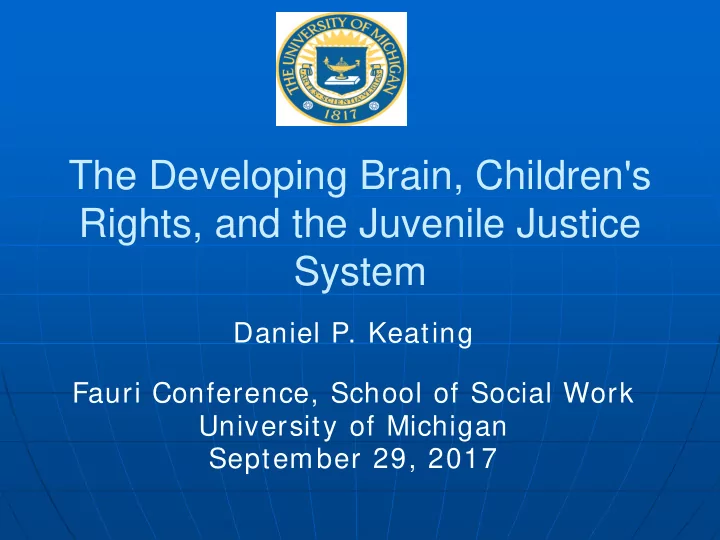

The Developing Brain, Children's Rights, and the Juvenile Justice System Daniel P. Keating Fauri Conference, School of Social Work University of Michigan September 29, 2017
Organization of Presentation ■ What have we learned about developmental maturity as it relates to juvenile justice? ■ What does the new neuroscience research tell us? ■ What are the major legal implications of this rapidly expanding knowledge?
Adolescence ■ For convenience, using ages 10 – 20 years (second decade of life) ■ Period of rapid transition in many domains ■ Not all changes are well coordinated
Developmental Maturity ■ Cognitive Development • Numerous important changes • No sharp age markers, especially in logic or risk assessment ■ Social Development • Increased behavioral autonomy • Increased peer interaction, influence, and susceptibility ■ Emotional Development • Increased moodiness, strength of emotions, likely hormonal (pubertal) as well as brain- based ■ “Judgment” • For all these reasons, develops slowly
Adolescent Neurodevelopment: “All Accelerator, No Brakes” Substantial increases in exploration and ■ sensation-seeking mechanisms, related to behavioral choice, romantic involvements, and risk taking behaviors. Also termed “bottom brain” or limbic system Growth in prefrontal cortex (“top brain”) also ■ begins during this transition, but is slower, lasting into the mid-20s. Thus, a “developmental maturity mismatch” may ■ underlie much adolescent risk behavior, including criminal activity and health risks.
Developmental Maturity Mismatch
Developmental Risks ■ Impulsivity: hard to stop a runaway train ■ “Planful” risk taking: exploring the world ■ BUT available PFC resources may be depleted with carrying out a plan that goes awry ■ Increased intensity of desires, wants ■ Internal checks from PFC (judgment) lag behind ■ At the same time that adult external “scaffolding” declines ■ Stress responses increase (physiologically), further impairing judgment
… especially for youth with a history of early life adversity: St. Martin’s Press, April 2017 stmartins.com/bornanxious
Implications for Justice Policy ■ Developmental maturity is a significant legal issue, with compelling science to indicate that there is a core developmental profile that characterizes adolescence ■ Legal relevance for • competence (ability to make legal judgments in proceedings) • culpability (mitigation) • rehabilitative prospects (character development still underway) ■ Especially, the age of assignment or transfer to adult jurisdiction needs to made carefully and individually.
Increasing Recognition by Supreme Court of Developmental Neuroscience ■ Earlier decisions focused more on culpability, and mitigation due to developmental immaturity ■ More recent focus on immaturity per se, and implications for rehabilitation (character not fully formed) ■ Neuroscience evidence seemingly persuasive ■ "Full maturity" from brain imaging suggests mid- 20s, so arguments to raise the age to match other markers (voting, contracts, children’s rights in UN CRC) have both scientific and legal/ justice support ■ Science can not provide precise markers, legal necessity for a firm line prevails
United Nations Convention on the Rights of the Child (CRC) ■ One benchmark is the CRC, which defines the “child” as up to age 18 years, with special claims to nurturance until that age. ■ “Rights” include those relevant to nurturance and to self-determination in the full range ■ Recognizes “evolving capacities,” but the evidence that adolescents are still in need of special protection is strong Keating, D. P. (2017). The Evolving Capacities of the Child: Neurodevelopment and Children’s Rights. In M. D. Ruck, M. Peterson-Badali & M. Freeman (Eds.), Handbook of Children's Rights: Global and Multidisciplinary Perspectives. Abingdon, UK: Taylor and Francis. Ruck, M.D., Keating, D. P., Saewyc, E. M., Earls, F., & Ben-Arieh, A. (2016). The United Nations Convention on the Rights of the Child: Its relevance for adolescents. Journal of Research on Adolescence, 26, (1), 16-29
Recommend
More recommend